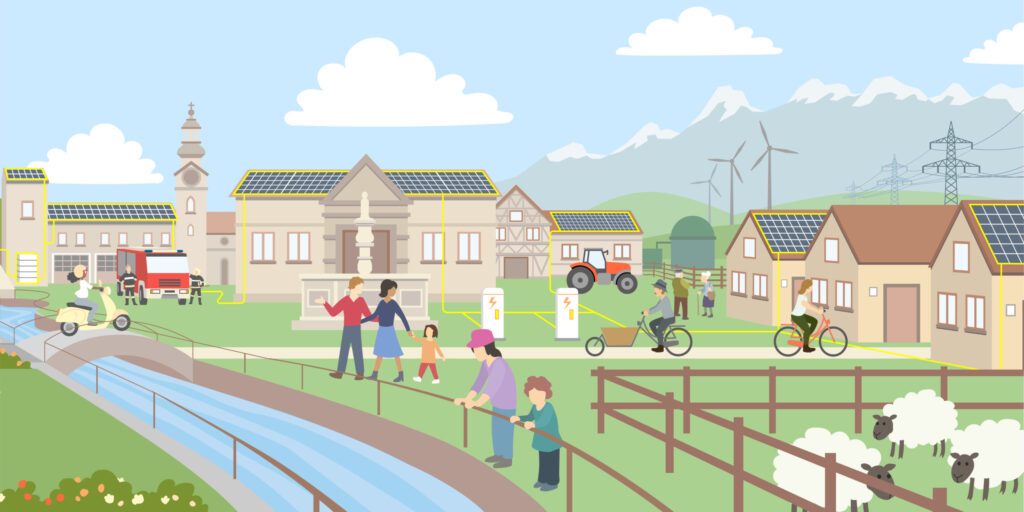Energy communities
Energy communities represent an important milestone in the energy industry: The participants generate and consume energy together and thus actively participate in the expansion of renewable energy. The SIR offers free advice & information on the subject of energy communities and supports initiatives in their establishment and further development. In addition, the SIR is part of the working platform for energy communities, an Austria-wide network that serves to provide a wide range of information and services, to promote practical implementation and to further establish energy communities as a central component of the energy system.
Depending on the type of energy community, energy can be jointly generated and utilised within a building, across property boundaries and even beyond local or national borders. A distinction is made between the following three models of energy communities (see diagram below):
- Joint generation plants (GEA)
- Renewable energy communities (EEG)
- Citizens’ energy communities (BEG)
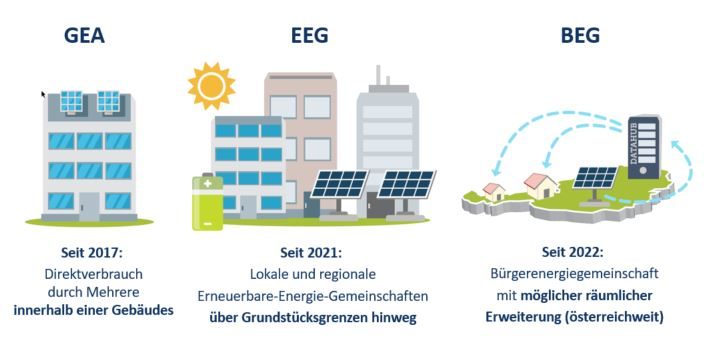
Joint generation plants (GEA)
Shared generation systems allow self-generated energy to be consumed within a property or building by several participants, for example through a photovoltaic system on the roof of a residential complex or shopping centre. Consumers who have a shared house connection are eligible to participate in the GEA.
Renewable energy communities (EEG)
Renewable energy communities enable the generation, consumption, storage and sale of renewable energy across property boundaries and are spatially limited. A local EEG is limited to the supply area of a local grid transformer (grid levels 6 and 7), while a regional EEG extends across the supply area of a transformer station (grid levels 4 and 5).
Citizens' energy communities (BEG)
Citizens’ energy communities can cover the supply areas of several grid operators and thus operate throughout Austria. In contrast to the EEG, only electricity may be generated, consumed, stored and sold in the BEG, and although large companies are authorised to participate, they are not permitted to exercise control.
Energy communities offer various advantages to private individuals, municipalities and companies. In addition to contributing to the energy transition, they promote the joint generation and use of energy, strengthen local value creation and provide financial incentives for members. Ultimately, energy communities should offer their participants and the region in which they operate ecological, social and economic benefits.
Ecological advantages
Energy communities enable active participation in the energy transition through the expansion and joint generation and utilisation of renewable energy. They also help to raise awareness and promote acceptance for the expansion of renewable energy.
Social community benefits
Energy communities strengthen regional cohesion by connecting private individuals, municipalities and businesses to actively contribute to the region. They offer a wide range of opportunities for participation and can be the starting point for further community initiatives. This can range from sharing concepts to activities in the area of energy poverty.
Economic advantages
Energy communities have the opportunity to set their own feed-in and consumption tariffs in order to achieve fair and stable prices. In the case of an EEG, there is also a financial incentive for consumers in the form of reduced grid fees and the elimination of the renewable energy subsidy and the electricity levy (see table below).
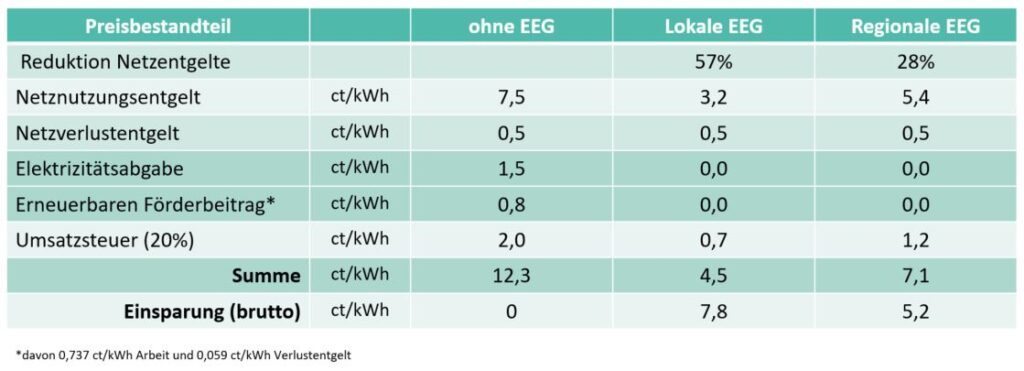
In recent years, energy communities have established themselves across Austria and are expected to continue to grow steadily. Interested parties generally have the option of participating in an existing energy community or setting one up themselves.
Teilnahme an einer Energiegemeinschaft
If you are interested in participating in an existing energy community, it is advisable to contact the respective initiative directly.
To find out whether or which energy communities already exist in your area or to obtain contact details, you can find here an interactive map with existing projects.
You can also enquire about existing energy communities in your area. We will be happy to connect you!
Foundation of an energy community
The establishment of an energy community requires a number of prerequisites to be fulfilled:
- A minimum of two participants: These are defined by at least two different natural or legal persons who each have at least one metering point.
- Own legal form: A separate legal form is required to implement an energy community.
- Local area: In the case of an EEG, the participants are supplied by the same local grid transformer or transformer station. You can find all the necessary information on this online map of the grid operator (Salzburg Netz GmbH).
- Other requirements: The main purpose of the energy community is not financial gain. Participation in the energy community is open and voluntary.
From the initial considerations to the ongoing operation of an energy community, several decisions and steps are required. The steps required to set up an energy community are as follows:

A detailed ‘step-by-step guide’ (downloads) also shows the exact steps up to the foundation in detail. We also recommend the following instructions for implementing an energy community:
https://energiegemeinschaften.gv.at/online-guide/
https://youtu.be/QFPnBT4jwUI
Municipal Energy Community Salzburger Seenland
The municipal EEG Salzburger Seenland has been in operation since March 2024, in which all municipalities of the Salzburger Seenland regional association with municipally owned buildings participate and exchange electricity across municipal borders. The existing regional association acts as the legal entity of the EEG, meaning that no additional organisation had to be created. The municipal energy community is gradually growing, so that as of February 2025, a total of 17 producers and 52 consumers are participating in the EEG in order to be able to jointly utilise even more electricity in the region. The project is being supported by the SIR and financed by the Climate and Energy Fund’s Energy Communities 2021 funding programme.
Over 200 renewable energy communities in Salzburg
After celebrating the 100th renewable energy community in the province of Salzburg in spring 2024, the current figures continue to show great interest. As of the beginning of 2025, over 200 renewable energy communities are already in operation. At the same time, the number of community generation plants has doubled in the past year to 490 plants. If the citizen energy communities are included, there are a total of 765 operating energy communities in the province of Salzburg with over 8,700 participants (as of January 2025).
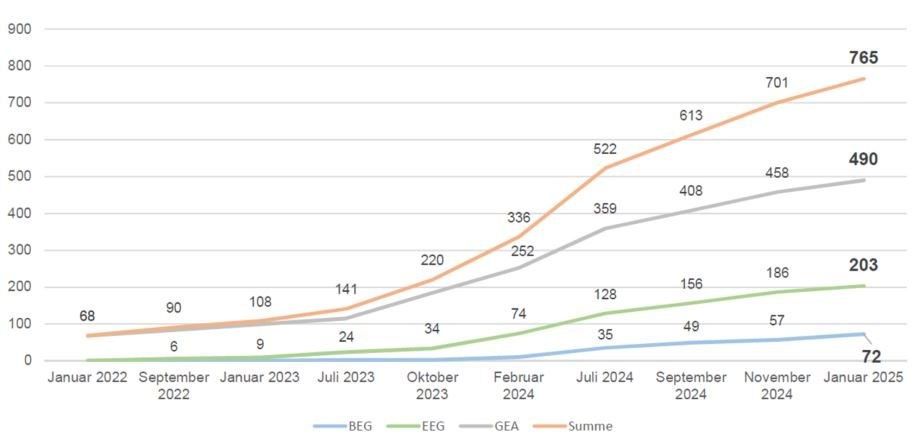

Fionn Herold, BSc, BEd, MA
Energy communities

DI (FH) Markus Schwarz, PMSc
Energy communities

Fabian Siam, BSc
Energy communities
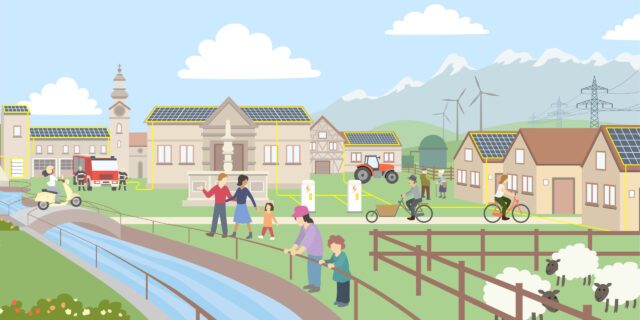
P.O. Box Energy Communities
